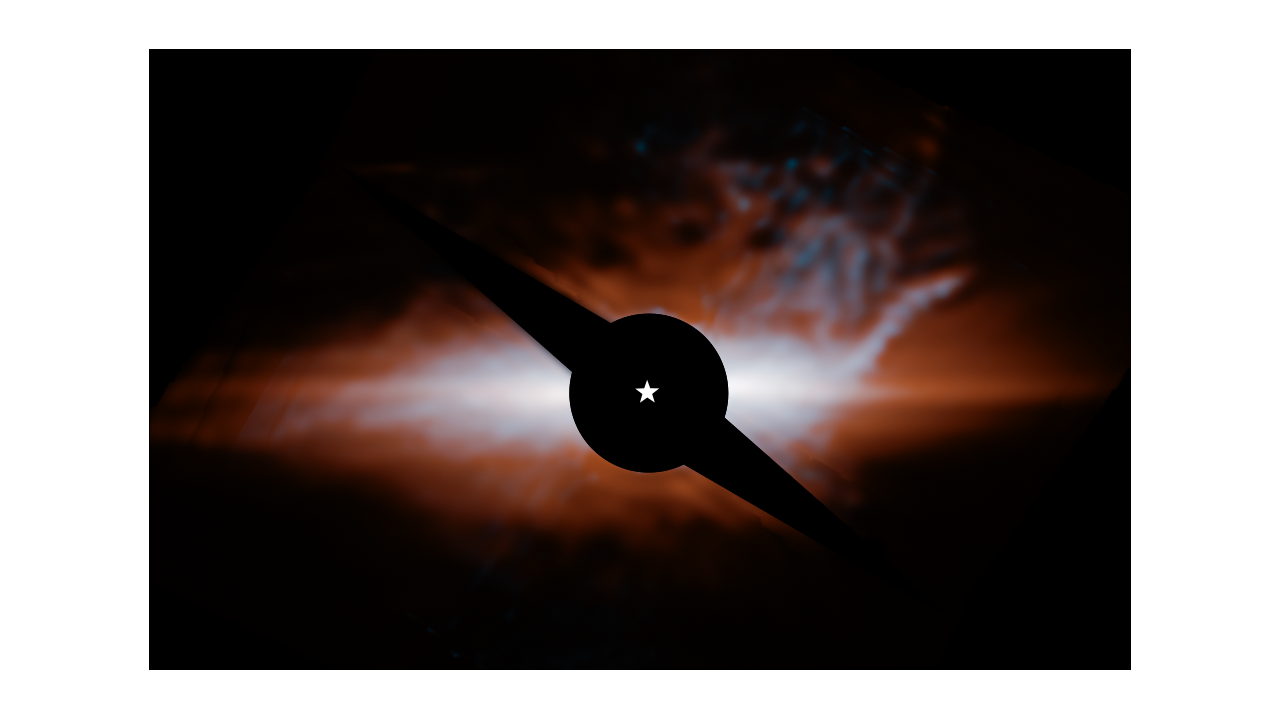
Beta Pictoris, a 4th-magnitude star some 63 light-years from Earth, has astonished researchers again. It’s already famous as the first star found to host a dusty disk of debris (which later turned out to be multiple disks). Now, new observations from the James Webb Space Telescope (JWST) have picked up a previously unseen feature: a dusty offshoot curled up like a cat’s tail. The structure is located on Beta Pictoris’ secondary disk, which is tilted in comparison with the initial disk astronomers first detected in the 1980s.
“Beta Pictoris is the debris disk that has it all: It has a really bright, close star that we can study very well, and a complex circumstellar environment with a multi-component disk, exocomets, and two imaged exoplanets,” said study lead author Isabel Rebollido of the Astrobiology Center in Madrid, Spain, in a statement. “While there have been previous observations from the ground in this wavelength range, they did not have the sensitivity and the spatial resolution that we now have with Webb, so they didn’t detect this feature.”
The discovery has been accepted for publication in the Astronomical Journal and are available on the preprint server arXiv. Th team also presented their findings at the 243rd American Astronomical Society Meeting in New Orleans earlier this month.
How was the feature found?
Astronomers first noticed an excess of infrared radiation coming from the Beta Pictoris system in 1983 — a hallmark of a dusty disk around the star, which was imaged a year later. In 2006, the Hubble Space Telescope confirmed the existence of two disks around the star. These disks are home to two known exoplanets: Beta Pictoris b and c.
JWST observed the star with both its NIRcam and MIRI instrument. The results showed that Beta Pictoris’ second disk and its dusty tail are both hotter than its primary disk. But “hot” is a relative term: These features cannot be seen at visible wavelengths, but glow when observed in mid-infrared. Researchers suspect they may be hotter because the dust located there is “organic refractory material,” which includes the carbon-rich molecules seen on comets and asteroids, per the press release. For example, debris collected from the asteroid Bennu is similar to that detected by MIRI around Beta Pictoris.
What formed the cat’s tail?
Researchers are still not entirely sure what caused the tail. They haven’t seen structures like this in the dust disks around other stars. Based on observations of other stars, shapes like these don’t usually form from disks.
They started by analyzing it to determine that it contains a large asteroid’s worth of dust, but spread out over 10 billion miles (16 billion kilometers).
What could have formed this? Using a computer model, the team thinks that a collision event 100 years ago may have sculpted the cat’s tail.
“At first, the dust goes in the same orbital direction as its source, but then it also starts to spread out. The light from the star pushes the smallest, fluffiest dust particles away from the star faster, while the bigger grains do not move as much, creating a long tendril of dust,” said study co-author Marshall Perrin, an astronomer at the Space Telescope Science Institute in Baltimore.
As for the specific shape, the team’s model — and others — suggest the sharply angled tail is an optical illusion. Although the dust is only inclined relative to the disk at a mere 5°, its curved shape combines with our unique line of sight from Earth to create the feline feature we see.









